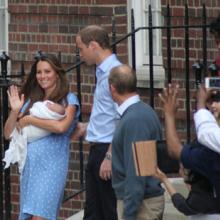Queen Elizabeth II
WE HAVE SEVERAL readings this month where God creates something out of nothing — or at least out of pretty limited materials. In the opening chapters of Genesis, we see creation birthed from God’s imagination and curiosity. In the story of Sarah and Abraham, a child is conceived in a womb so postmenopausal that the now-pregnant woman can’t help but laugh (Genesis 18). A well appears from nowhere to quench the thirst of a dying woman and her child (Genesis 21:19). God “calls into existence the things that do not exist” (Romans 4:17). And God turns death to life through the mysteries of resurrection (Romans 6:1-11).
This month’s lectionary readings make God’s continuous creation — as well as God’s continual renewal of creation — explicit. But the fact is, once we’re looking for it, all of scripture tells these stories of renewal. God is always creating, re-creating, and reimagining our world. God is always making a way where there was no way before. God continually turns death to life. And, just as importantly, we are called to participate in God’s divine practices of continuous creation, in God’s own divine practice of everyday resurrection.
As we exit a series of some of the higher holy seasons in the liturgical year — Epiphany, Lent, Easter, and Pentecost — June quiets down from such intensity. The slower pace to which (in some places) the warm summer sun calls us can inspire us to seek out everyday resurrection wherever God hides it. How is the Spirit calling you to partner with divine practices of renewal, with everyday resurrections?

Image via UK Home Office/Flickr
David Cameron stepped down from his role as prime minister of the United Kingdom on July 13, as he had announced after the Brexit vote.
In his resignation speech in front of 10 Downing Street, the traditional residence of the prime minster, Cameron called his tenure “the greatest honor” of his life. He will continue to serve in parliament as a representative of Witney.
Prince George is now officially named and an Anglican.
The 3-month old royal baby was christened Wednesday, ritually welcomed into the Church of England as Prince George Alexander Louis of Cambridge, in a private ceremony for close family and friends in the historic chapel of a London royal palace.
His parents, Prince William and Duchess Kate of Cambridge, grandparents, great-grandparents, and seven godparents looked on as the baby was baptized by the Archbishop of Canterbury Justin Welby, in an antique silver font in the Chapel Royal of St. James’s Palace as a small scarlet-and-gold-clad choir sang hymns.
England and Wales became the 16th and 17th countries in the world to recognize gay marriage after Queen Elizabeth II gave “royal assent” to a same-sex marriage bill.
Under the new law, gay men and women will be able to join together in civil ceremonies or in church services — although no religious denomination will be forced to carry out such services.
Cheers, laughter, and clapping broke out in the House of Commons when Speaker John Bercow announced the bill had been approved.


